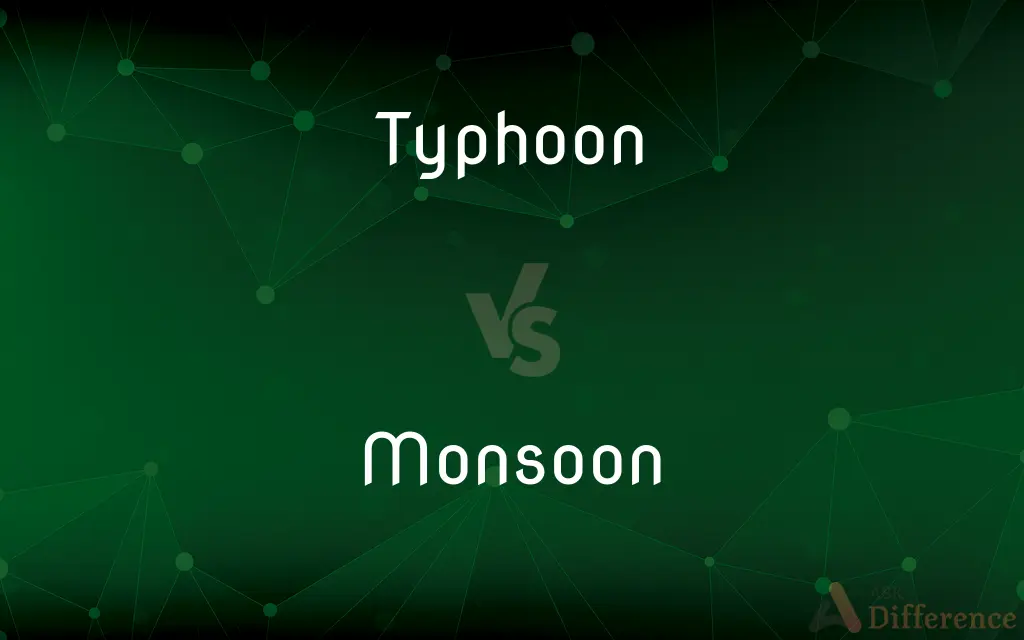Typhoon vs. Monsoon — What's the Difference?
By Tayyaba Rehman — Updated on June 7, 2024
A typhoon is a tropical cyclone originating in the Northwest Pacific; a monsoon is a seasonal wind shift bringing heavy rains.

Difference Between Typhoon and Monsoon
Table of Contents
ADVERTISEMENT
Key Differences
Typhoons and monsoons are both atmospheric phenomena but serve different roles in the Earth's climate system. A typhoon is essentially a tropical cyclone that forms over warm waters in the Northwest Pacific Ocean. These systems are characterized by their intense winds and torrential rains. In contrast, a monsoon is not a single storm but a seasonal wind shift, often associated with a differentiating temperature between the sea and the land.
While typhoons can be violent and cause significant damage, their occurrences are relatively isolated events that happen when conditions in the ocean and atmosphere are just right. On the other hand, monsoons occur on a predictable annual cycle. They bring seasonal rain to many parts of the world, particularly South Asia, where the summer monsoon rains are critical for agriculture.
The origins of these two phenomena are also different. Typhoons form from disturbances in the atmosphere, especially over warm ocean waters where there's ample moisture to fuel their growth. Monsoons, however, are driven by larger-scale atmospheric patterns. As land heats up during the summer, it causes low pressure which attracts moist air from the ocean, leading to heavy rains.
Despite their differences, both typhoons and monsoons can have profound impacts on the regions they affect. Typhoons can bring destruction through their intense winds, storm surges, and heavy rains. Conversely, monsoons, while beneficial for crops, can also lead to flooding if the rains are too heavy or prolonged.
Comparison Chart
Definition
A tropical cyclone in the Northwest Pacific
A seasonal wind shift bringing heavy rains
ADVERTISEMENT
Frequency
Isolated events based on atmospheric conditions
Predictable annual cycle
Origin
Disturbances over warm ocean waters
Larger-scale atmospheric patterns
Impact
Can cause destruction with winds, surges, and rains
Beneficial for crops but can lead to flooding
Duration
Relatively short-lived events
Lasts for an entire season
Compare with Definitions
Typhoon
A tropical cyclone specific to the Northwest Pacific region.
The typhoon devastated the coastal town last year.
Monsoon
A seasonal wind pattern resulting in significant rainfall.
The crops flourished during the monsoon season.
Typhoon
A typhoon is a mature tropical cyclone that develops between 180° and 100°E in the Northern Hemisphere. This region is referred to as the Northwestern Pacific Basin, and is the most active tropical cyclone basin on Earth, accounting for almost one-third of the world's annual tropical cyclones.
Monsoon
A periodic wind shift influenced by land and sea temperature differentials.
The onset of the monsoon brings relief from the summer heat.
Typhoon
An intense storm system with a spiraling wind pattern.
Coastal areas are often evacuated when a typhoon is forecasted.
Monsoon
A monsoon is traditionally a seasonal reversing wind accompanied by corresponding changes in precipitation, but is now used to describe seasonal changes in atmospheric circulation and precipitation associated with annual latitudinal oscillation of the Intertropical Convergence Zone between its limits to the north and south of the equator. Usually, the term monsoon is used to refer to the rainy phase of a seasonally changing pattern, although technically there is also a dry phase.
Typhoon
A powerful weather event originating over warm waters.
Boats were anchored safely before the typhoon hit.
Monsoon
Entire meteorological systems with such characteristics.
Typhoon
A natural disaster known for its wind speeds and heavy rains.
Infrastructure is built robustly in regions frequently hit by typhoons.
Monsoon
The rainy phase of the larger Asian weather system.
Farmers rely on the monsoon rains for their agricultural yield.
Typhoon
A tropical cyclone occurring in the western Pacific or Indian Oceans.
Monsoon
A climatic phenomenon vital for many ecosystems and economies.
Tourists often avoid the region during the heavy monsoon period.
Typhoon
The Asian term for a hurricane or cyclonic storm.
Many residents are well-prepared for the annual typhoon season.
Monsoon
A wind system that influences large climatic regions and reverses direction seasonally.
Typhoon
A weather phenomenon in the northwestern Pacific that is precisely equivalent to a hurricane, which results in wind speeds of 64 knots (118 km/h) or above. Equivalent to a cyclone in the Indian Ocean and Indonesia/Australia.
Monsoon
A wind blowing part of the year from one direction, alternating with a wind from the opposite direction; - a term applied particularly to periodical winds of the Indian Ocean, which blow from the southwest from the latter part of May to the middle of September, and from the northeast from about the middle of October to the middle of December.
Typhoon
(intransitive) To swirl like a hurricane.
Monsoon
A wind from the southwest or south that brings heavy rainfall to southern Asia in the summer.
Typhoon
A violent whirlwind; specifically, a violent whirlwind occurring in the Chinese seas.
Monsoon
The season in which the monsoon occurs.
Typhoon
A tropical cyclone occurring in the western Pacific or Indian oceans
Monsoon
A similar seasonal wind, as in the southwest United States, that brings increased rainfall.
Monsoon
The rain that comes with any of these winds or wind systems.
Monsoon
A heavy rainfall in India associated with the southwest monsoon{1}.
Monsoon
Characterized by prolonged wet spells in certain regions.
The city's drainage system is tested every monsoon.
Monsoon
Any of a number of winds associated with regions where most rain falls during a particular season.
Monsoon
Tropical rainy season when the rain lasts for several months with few interruptions.
Monsoon
The rains themselves.
Monsoon
A seasonal wind in southern Asia; blows from the southwest (bringing rain) in summer and from the northeast in winter
Monsoon
Rainy season in southern Asia when the southwestern monsoon blows, bringing heavy rains
Monsoon
Any wind that changes direction with the seasons
Common Curiosities
What is a typhoon?
A typhoon is a tropical cyclone that forms in the Northwest Pacific region, characterized by strong winds and heavy rainfall.
Why are monsoons so vital for certain regions?
Monsoons play a crucial role in replenishing water sources, supporting agriculture, and maintaining ecosystems in regions like South Asia.
What is a monsoon?
A monsoon is a seasonal wind pattern change, primarily influenced by land and sea temperature differentials, often resulting in prolonged heavy rainfall in specific regions.
How does a typhoon differ from a hurricane?
While both are intense tropical cyclones, the term "typhoon" is used for storms in the Northwest Pacific, whereas "hurricane" is used for those in the Atlantic and Northeast Pacific.
How do typhoons form?
Typhoons form from disturbances over warm ocean waters where the atmospheric conditions are conducive, leading to a spiraling wind pattern and intense storm system.
How long does the monsoon season last?
Monsoon seasons can vary by region, but they typically last several months, marking a distinct rainy phase in the year.
Are typhoons only limited to the Pacific region?
The term "typhoon" is specific to the Northwest Pacific, but similar storm systems occur worldwide and are called hurricanes or cyclones based on their location.
Can typhoons be predicted?
With modern meteorological techniques and equipment, the formation and path of typhoons can often be predicted with reasonable accuracy, allowing for precautions and evacuations.
Is it true that monsoons only bring rain?
While monsoons are often associated with heavy rainfall, they can also bring dry spells in certain regions, known as the dry monsoon.
Do monsoons impact global weather patterns?
Yes, monsoons can influence global weather patterns, especially since they can affect large-scale atmospheric circulation and ocean currents.
Share Your Discovery

Previous Comparison
Kitchen vs. Pantry
Next Comparison
Millimeter vs. MicronAuthor Spotlight
Written by
Tayyaba RehmanTayyaba Rehman is a distinguished writer, currently serving as a primary contributor to askdifference.com. As a researcher in semantics and etymology, Tayyaba's passion for the complexity of languages and their distinctions has found a perfect home on the platform. Tayyaba delves into the intricacies of language, distinguishing between commonly confused words and phrases, thereby providing clarity for readers worldwide.
















































